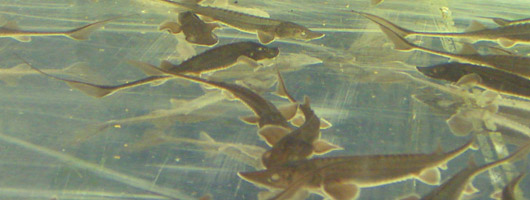
Juvenile Sturgeon
In 2005, a groundbreaking fisheries flume study examining the effects of substrate, water depth, light use, and the influence of water velocity by juvenile Pallid and Shovelnose Sturgeon was conducted at AREC by Dr. Teresa Allen.
Abstract
We investigated the influence of substrate type, water depth, and light, on microhabitat selection in juvenile pallid (Scaphirhynchus albus) and shovelnose (Scaphirhynchus platorynchus) sturgeon at two water velocity levels. Individuals and groups of sturgeon were placed in a 315 cm by 835 cm (18,927 L; 5000 gal) elliptical flume, and their distributions were recorded every 10 minutes over a two hour period. Data were analyzed as contingency tables using an exact Kruskal-Wallace of two ordered multinomials to test for differences in distributions. Overall, individuals and groups used sand significantly more and gravel significantly less than expected (P < 0.0001 all cases). Use of sand/gravel mixture and woody structure was not significantly different than expected. Water depth was categorized into shallow, medium, and deep areas based on equal interval distributions. Individuals and groups all used deep areas significantly more, and medium and shallow areas less than expected based on availability (P < 0.0001 all cases), with the exception of individual shovelnose, in which case the use of medium depth areas was not significantly different than expected (P = 0.1642). Light was categorized into very light, light, dark, and very dark areas. Individuals and groups all used very dark areas significantly more than expected based on availability (P < 0.0001 all cases). Use of dark areas by individual shovelnose (P = 0.0013), groups of pallids (P = 0.0446), and groups of shovelnose (P <0.0001) was significantly more than expected based on availability. Proportional availability and use of dark areas did not differ significantly in individual pallids (P = 0.0839) and mixed species groups (P = 0.7707). All used light areas significantly less than expected (P < 0.0001 all cases). Additionally, individual shovelnose (P < 0.0001), groups of pallids (P < 0.0001), and mixed species groups (P <0.0001) all used very light areas significantly less than expected (P < 0.0001 all cases). Use of very light areas by individual pallids (P = 0.5026), and groups of shovelnose (P = 0.3547) did not differ significantly from availability. This study is the first investigation of juvenile pallid and shovelnose sturgeon habitat selection in a large-scale artificial stream system. Field studies of microhabitat selection by juvenile pallid and shovelnose sturgeon should be carried out to substantiate the results of this study, and to identify critical habitat for recovery and management of sturgeon species. Proper management of the species likely requires river improvements that provide sturgeon with access to a broad range of habitat conditions over time, including system-wide habitat diversity; natural variation in flow, velocity, temperature, and turbidity; high water quality; a broad prey base; and free-flowing sections which provide suitable spawning and rearing sites.
